Dee Estuary Birding
Monthly Newsletter...
March 2021
Newsletter
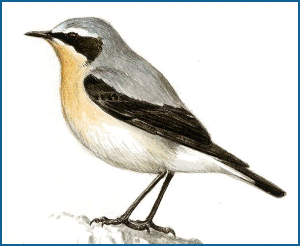
Highlights March 2020 to February 2021
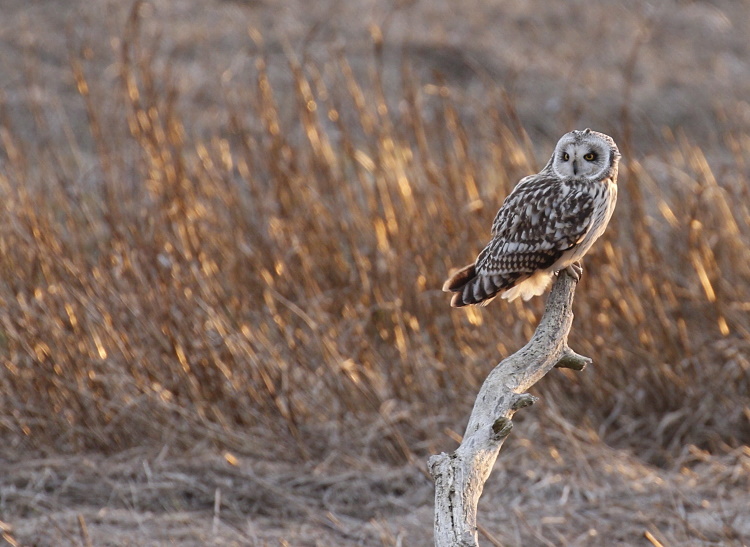
March 2021 marks the 23rd Anniversary of 'Dee
Estuary Birding' and I do my usual review of the previous 12 months.
Certainly a strange and bizarre 12 months. Hilbre, Burton Mere Wetlands
and the Connah's Quay Reserve were all closed for several weeks, as was
the whole of Wales to English birders and vice versa. However, most of
us managed to do a bit of local birding during our daily exercise and
there were certainly plenty of birds to see.
Spring Migration
Spring migration was relatively quiet after the excitement of the previous year. There were plenty of Whinchats passing through North Wirral with a total of 32 records, and good numbers of Redstarts and Ring Ouzels. Up to 62 White Wagtails were on Holylake shore during their migration to Iceland. A nice record was of a Pied Flycatcher in Ashton Park, West Kirby, but the most unexpected sighting was of 10 Water Pipits at Heswall in April.
Waders
The northward passage of Avocets reached 112 at
Burton Mere Wetlands in March although they had a below average
breeding season there due to the the spring drought. Whimbrels were
flying
north in good numbers in May and the max count of 142 at Heswall was
one of the highest ever for the Dee estuary.
More unexpected were four Curlew Sandpipers at
Hoylake in May when they are a rare sight. It was also a very good
autumn for this species, in the first half of September we had peak
counts of 10 at Burton Mere Wetlands, 16 at Hoylake and 10 at
Heswall.
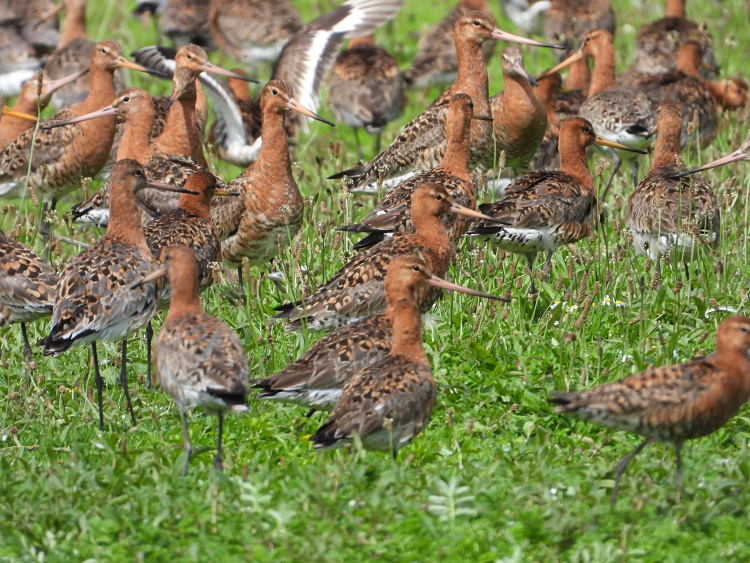
For many waders the autumn begins in late June when
they start returning to the estuary after breeding. I always look
forward to seeing the Black-tailed Godwits looking spectacular in full
breeding plumage and the first ones were seen right at the end of June
at Caldy. They quickly built up in numbers to reach an incredible 6,230
by August 21st, over 5% of the total Icelandic population.
After hearing about record numbers of Knot on the Wash in October our expectations were that good numbers would come over here and they reached a maximum of around 40,000 in November, well above the five year average 16,000. I certainly had some great moments with them this winter searching for colour rings and flags, including several spectacular high tide roosts at Hoylake. Most of the Knot were feeding out on the estuary off Thurstaston, Caldy and West Kirby and this is the same area where there have been large numbers of Oysyercatchers - the sand banks have been covered with them and the racket they make is amazing. Not sure of total numbers for the estuary but it must have been be well over 30,000 this last winter.
Hilbre had 17 Purple Sandpipers roosting in January,
the highest number for several years.
Out to Sea
It was relatively quiet out in Liverpool Bay through
the year without any major influxes or passages, but still plenty to
see. At least 60 Red-throated Divers were on a flat calm sea on March
20th and April saw a good passage of Arctic Terns including 40 past
Hoylake. It was a good spring and summer for Gannets with several days
when hundreds flew past including 618 counted from Hoylake in late
July. Strong winds in early September unfortunately didn't persist so
only a few Leach's Petrels came through, but three Pomarine Skuas in
October was a nice bonus.
Through the winter there were several reports of a
Long-tailed Duck, plus a few Velvet Scoters and Eiders. There were no
huge flocks of Common Scoters which we sometimes see but a count of 306
Great Crested Grebes was the biggest number for a couple of years.
Right at the end of February a Slavonian Grebe was off Hilbre.
The Marshes and Burton Mere Wetlands
March saw at least 20,000 Pink-footed Geese on the
estuary, a record high. Three pairs of Great Egrets and three pairs of
Bearded Tits bred at Burton Mere Wetlands. Also two pairs of Marsh
Harriers bred, with a third at Parkgate showing signs of a breeding
attempt but they seemed to lose interest. There were plenty of Marsh
Harriers spotted through the winter but numbers didn't seem to be as
high as the previous two winters. At least two grey males Hen Harriers
spent the winter here with a few ring-tails. As reported elsewhere in
this newsletter one of the grey males was ringed in Texel in the
Netherlands. A Bittern
was seen regularly flying in to roost at Neston reed-bed through the
winter. Egrets continue to increase with 13 Cattle Egrets at Burton in
October and 39 Great Egrets in November.

Scarce and Rare
Four Common Cranes flew over in mid-April and May
brought us a Blue-headed Wagtail, a Turtle Dove and a Hoopoe. The good
weather in spring and early summer seemed to prove particularly
attractive to Quails with at least three recorded calling away in the
fields. A Purple Heron was probably the rarity of the year, it was seen
at Burton and Parkgate in August. A family of Spotted Crakes were at
Burton Mere Wetlands in August with the last sighting in early October.
One that got away was a probable Lesser Yellowlegs at Thurstaston in
September, unfortunately the view of it was too short to be 100%
certain and it could not be relocated. A Grey Phalarope was an
unexpected arrival near Flint in January. Eight Snow buntings were at
Hoylake for at least two months through the winter, the best showing of
these birds for many years. 12 Crossbills showed really well by Ness
Gardens for several days in February, loads of photos were taken of
these photogenic birds.

Richard Smith.
Colour Ring Report
Hen Harrier
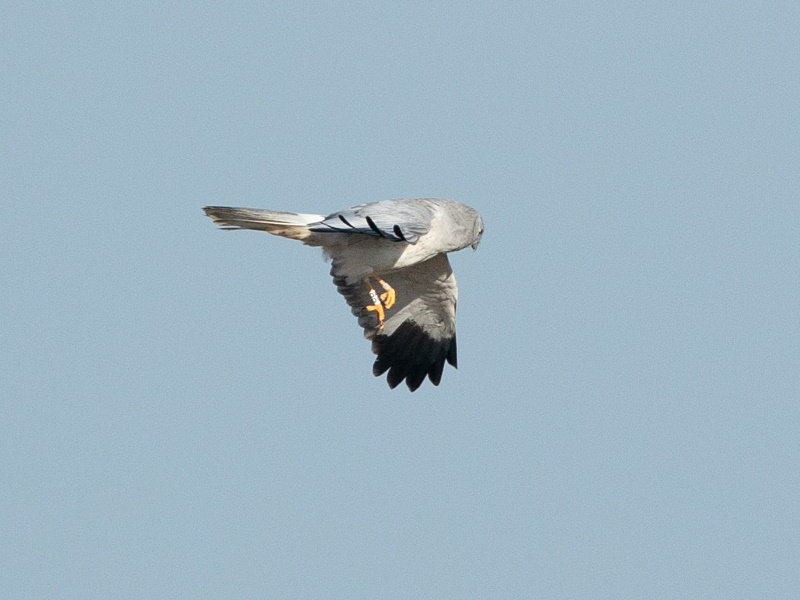
https://www.andy-davis-photography.com/
CD - black
on white ring left leg.
Ringed on the island of Texel, Netherlands, on June 25th 2019.
Recorded at Gronant on February 12th 2021.
This record undoubtedly takes pride of place in this
month's Colour Ring Report. My first thought was that this was a
surprising movement as I, along with many others, have always assumed
that all our over-wintering Hen Harriers originate in this country
perhaps breeding in Wales and the Isle of Man. But a look at the BTO
Ringing Report reveals that more Hen Harriers come from the Netherlands
to the UK than from any other foreign country, and by a large margin.
In total 11 Hen Harriers ringed in the Netherlands have been recovered
in the UK, compared with just two from Belgium and singles from four
other countries.
Knots
A new Photographic
Guide to Colour-ringed Red Knot has been published which
should
prove very useful to all colour ring enthusiasts - Click Here to download it (PDF File).
Also for those wondering what the Dutch ringing codes for waders such
as N8RYYN and Y4RNRR actually mean here is a guide to download - Click
here (PDF file).
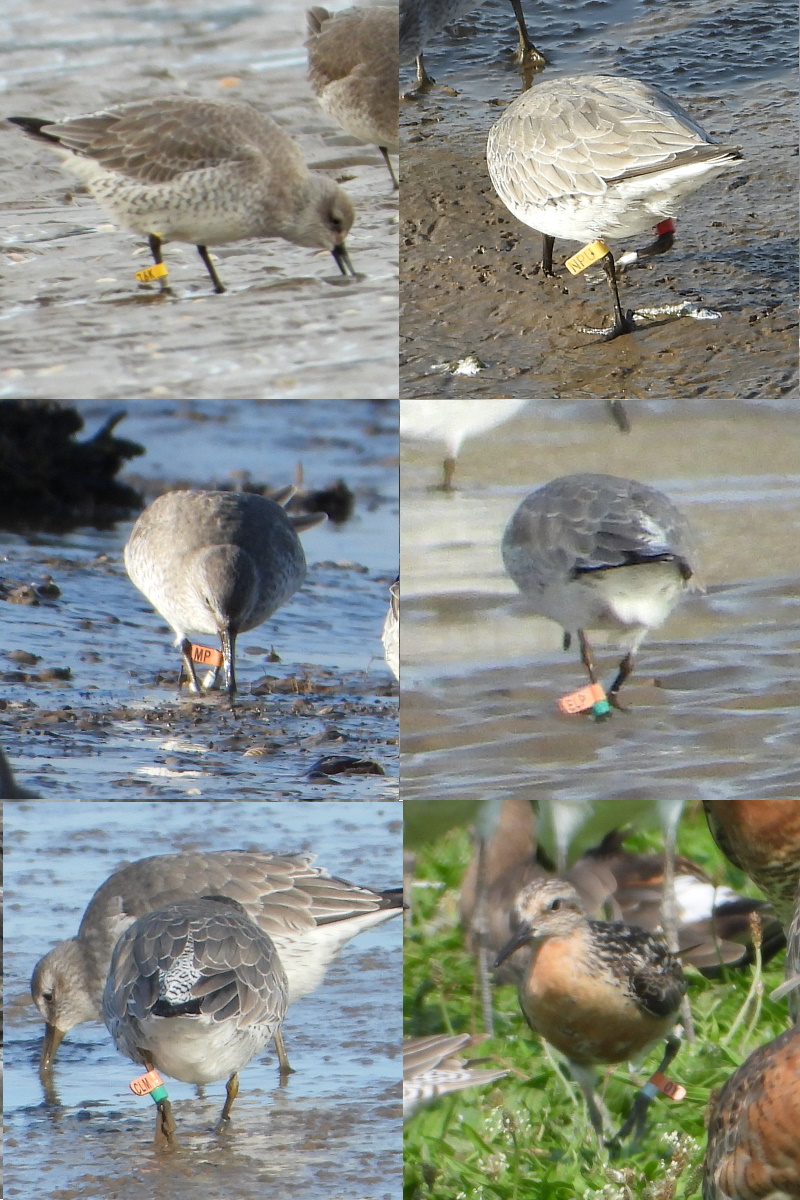
Regular readers of this newsletter will know
that our Knots are being intensively studied by means of their colour
rings and flags. Over several years, but mainly over the past four
years, we have amassed an amazing 3,800 records on the Dee Estuary
alone, with many more records coming from the Sefton coast and
elsewhere from the northern tip of Norway to the Canary Islands. Some
birds we literally have dozens of records for, including one described
below, but others get spotted maybe a couple of times then just
disappear for several years before unexpectedly turning up just when
we've assumed they are deceased! This last winter we seem to have seen
several that fall into that category and I describe five below:
Yellow flag 76K
(photo top left).
Ringed at SW Iceland in May 2017.
Recorded at West Kirby on December 30th 2020.
It is thought that nearly all the Liverpool Bay population of Knots
(i.e. those that arrive here in July/August and stay all winter and
leave in April/May) pass through south-west Iceland in May on their way
to breed in Canada. But it seems this one is likely to have spent it's
winters elsewhere.
Yellow flag NPU
(photo top right).
Ringed on the northern tip of Norway way back in May 2013.
This bird undergoes post breeding moult on the Dutch Waddensea having
been recorded there in late summer/autumn in 2014, 2016 and 2017.
There were no other records until it was seen at Meols in February 2021.
Orange
flag MP
over pale blue (photo middle left).
Ringed in September 2017 near the Alt Estuary.
This bird is special for me as it was the first 'O' flagged bird I ever
saw, indeed the first 'O' flagged bird anybody had seen apart from when
it was ringed. It was at Caldy Wildfowl Collection the day after it was
ringed, the first ringed Knot I'd ever seen there and I was completely
unaware of the catch which had been carried out the day before. I
remember emailing Jim Wilson 'I've seen this knot with a strange Orange
flag' little realising it would be the first of hundreds!
It was recorded at Caldy up until early November before it was seen at
Thurstaston where it spent the winter. That April (2018) it returned
briefly to Caldy then, being an immature bird, it spent the summer in
Morecambe Bay.
It had not been recorded since early September 2018 so I was really
pleased when I saw it in front of me just by the causeway at
Thurstaston in November 2020.
Orange
flag ELP
over green (photo middle right).
Ringed in March 2018 near the Alt Estuary.
Recorded at West Kirby in late January and early February 2021.
Knowing how intensively the knot flocks are being watched on the Dee
Estuary, Sefton Coast and the Dutch Waddensea it always surprises me
when we spot a 'new' one from the original catches in September 2017
and March 2018. This winter we saw five never recorded before, where
have they been?
Orange flag CLM
over green (photo bottom left).
Ringed in March 2018 near the Alt Estuary.
Recorded on the northern tip of Norway in May 2019.
Recorded at Hoylake in December 2020 and at Meols in February 2021.
Nearly all those Knot with an Orange flag are part of the Liverpool Bay
population which migrate through Iceland in May. The other population
which visit us in winter which moult in the Waddensea have two
migration routes north with some also flying via Iceland whilst others
fly via northern Norway. CLM must be part of the latter population
migrating via Norway. Interestingly we've only ever recorded two Orange
flagged birds here on the Dee estuary which have been observed using
this Norwegian route, both seen this winter.
Orange flag 0Y over
pale blue
(photo bottom right).
Ringed in September 2017 near the Alt Estuary.
Of all the Orange
flagged Knot we've observed here on the Dee Estuary this one has been
recorded the most times, 40 in total. It visited Caldy Wildfowl
Collection shortly after it was ringed in autumn 2017, and was also
recorded there in 2018 and 2020. In May 2018 it was in SW Iceland. It's
also been recorded at Thurstason, Leighton Moss, Formby, Crosby,
Ainsdale, Southport, Heysham and Marshside RSPB.
Grey Plovers
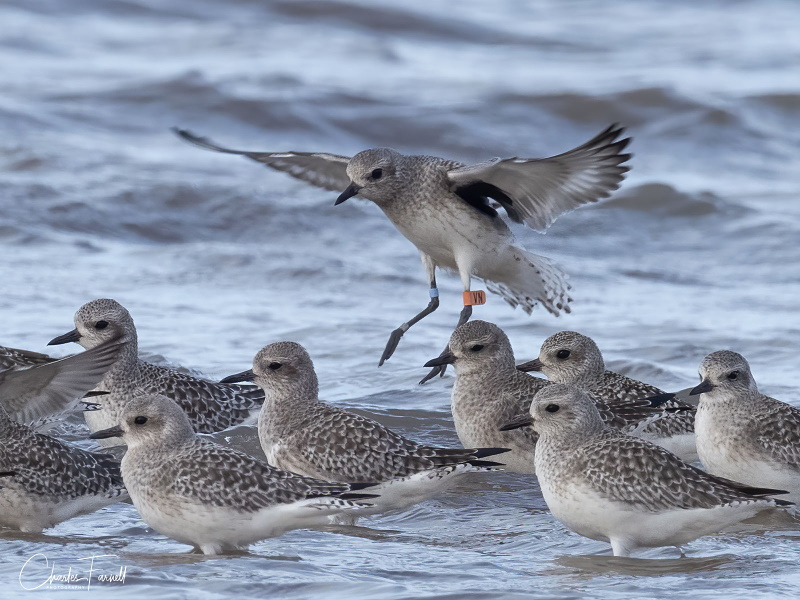
Dunlin
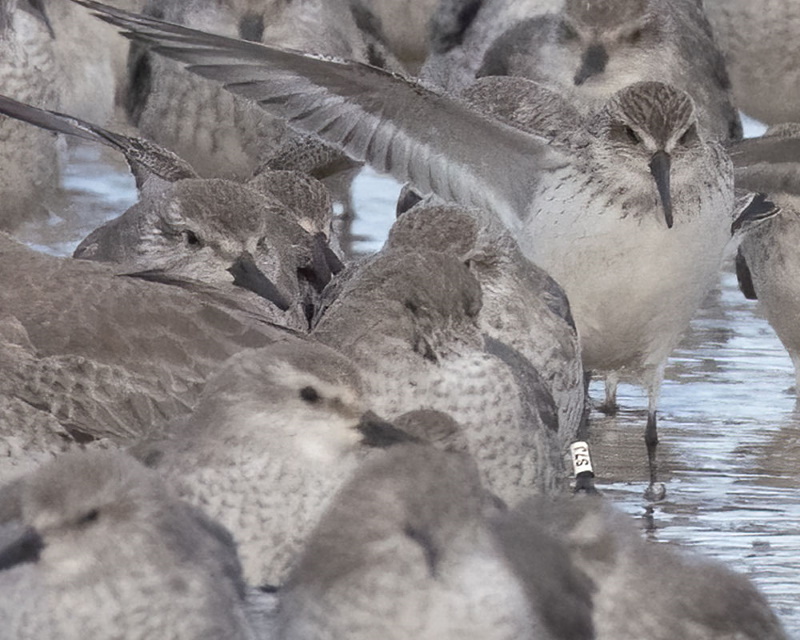
S7J - black on white ring.
Ringed near Gdansk, Poland, in July 2017.
Recorded at Hoylake on February 16th 2021.
No other records. This is the 16th Dunlin we have recorded on the Dee Estuary which have been ringed in Poland.
Black-headed Gull
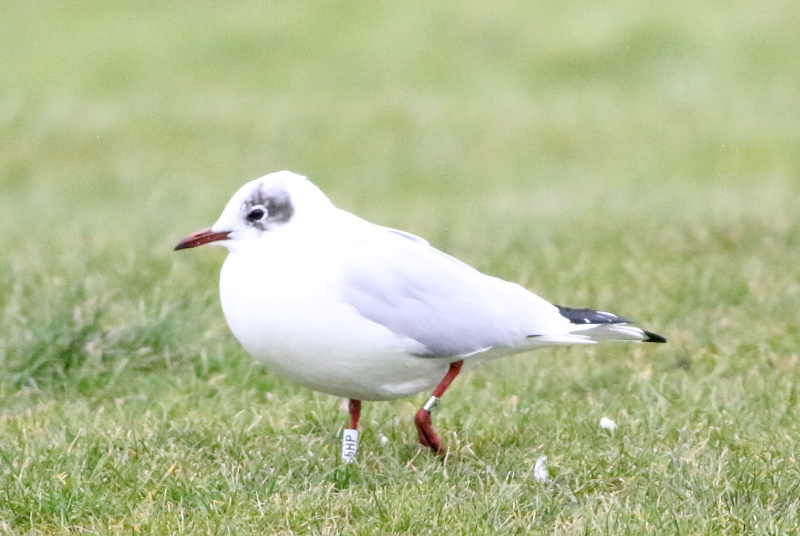
5HP - black on white ring.
Ringed in Copenhagen in March 2015.
A real regular at New Brighton being recorded 25 times there including
twice in February 2021. The only other records were back in Denmark in
July 2019 and at Seaforth in August 2020.
Common Gull

Ringed in Aberdeen in June 2013.
Recorded:
Back in Aberdeen in July 2014.
Wallasey in the autumns of 2014, 2015 and 2018.
Hoylake in September 2020.
New Brighton on February 14th 2021.
Colour-rings were recorded by Richard
Smith, Steve
Hinde, Andy Davis, John Jay, Charles Farnell, Steve Williams, Ken
McNiffe and Sean
O'Hara.
February Bird News
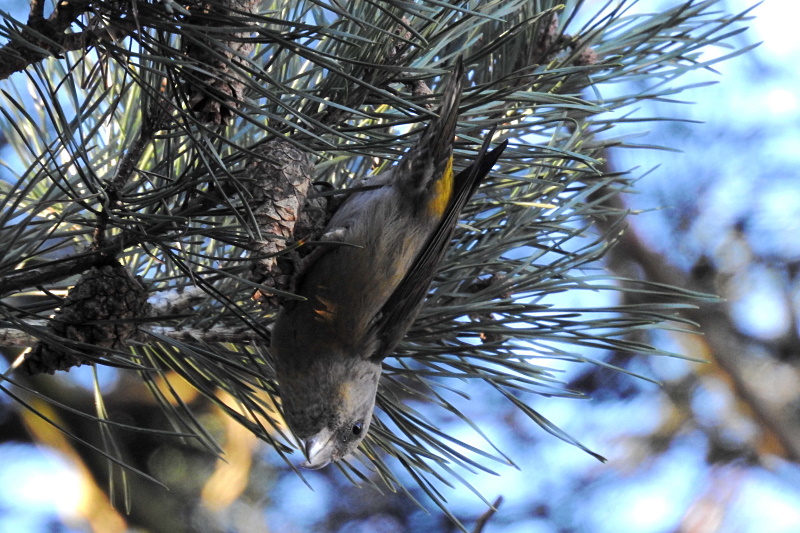
12 Crossbills arrived on the 17th at Ness Gardens giving great views
and remained until the end of the month. Crossbills aren't all that
rare but most records are of just brief views before they move on so
it's great to see this number for so long. And the same applies to the
eight Snow Buntings which arrived at the end of 2020 along north Wirral
and are still here as I write this.
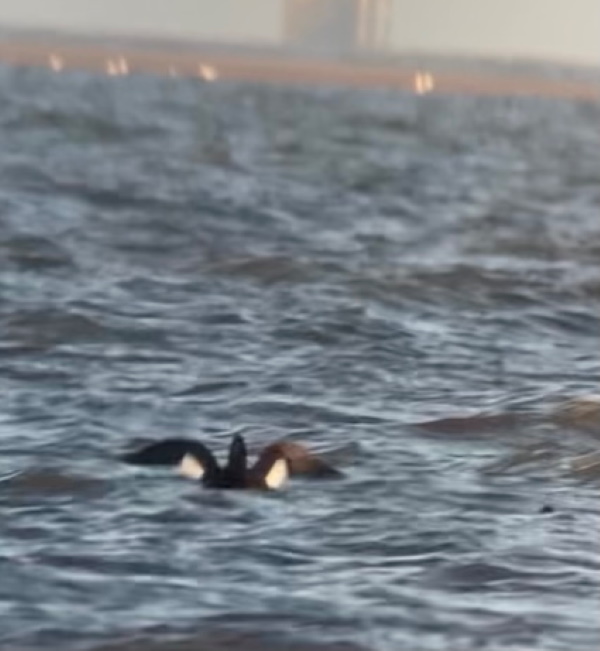
There were a good selection of sea ducks off Hilbre and north Wirral including at least two Eiders, three Velvet Scoters, a Long-tailed Duck, a Scaup as well as the usual hundreds of Common Scoters. There were also a good number of Great Crested Grebes out there with 306+ counted on the 3rd and a much rarer Slavonian Grebe was spotted from Hilbre on the 28th.
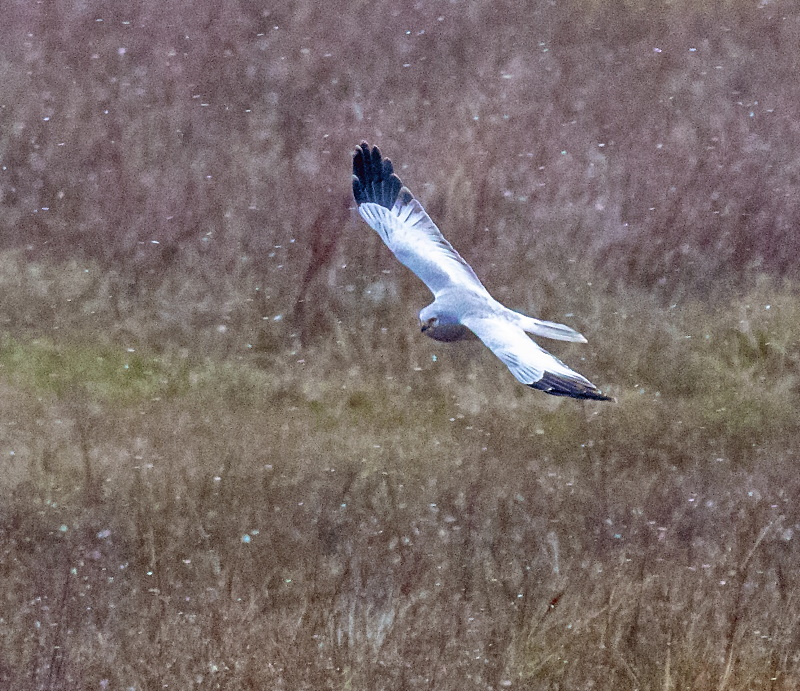
There were several reports of grey male Hen Harriers with sightings coming from both Gronant and the more usual sites along the marshes off Heswall, Parkgate and Neston.
We had a very early Wheatear at Meols on the 28th, although not as early as 2019 when we had the first one on the 27th.
There was a notable Stonechat passage through the region including eight in the horse paddocks by Leasowe Lighthouse on the 22nd. A Firecrest was a nice find at Heswall on the 11th. Yellowhammers are getting increasingly scarce on Wirral so six seen at Thornton Hough was an excellent find.
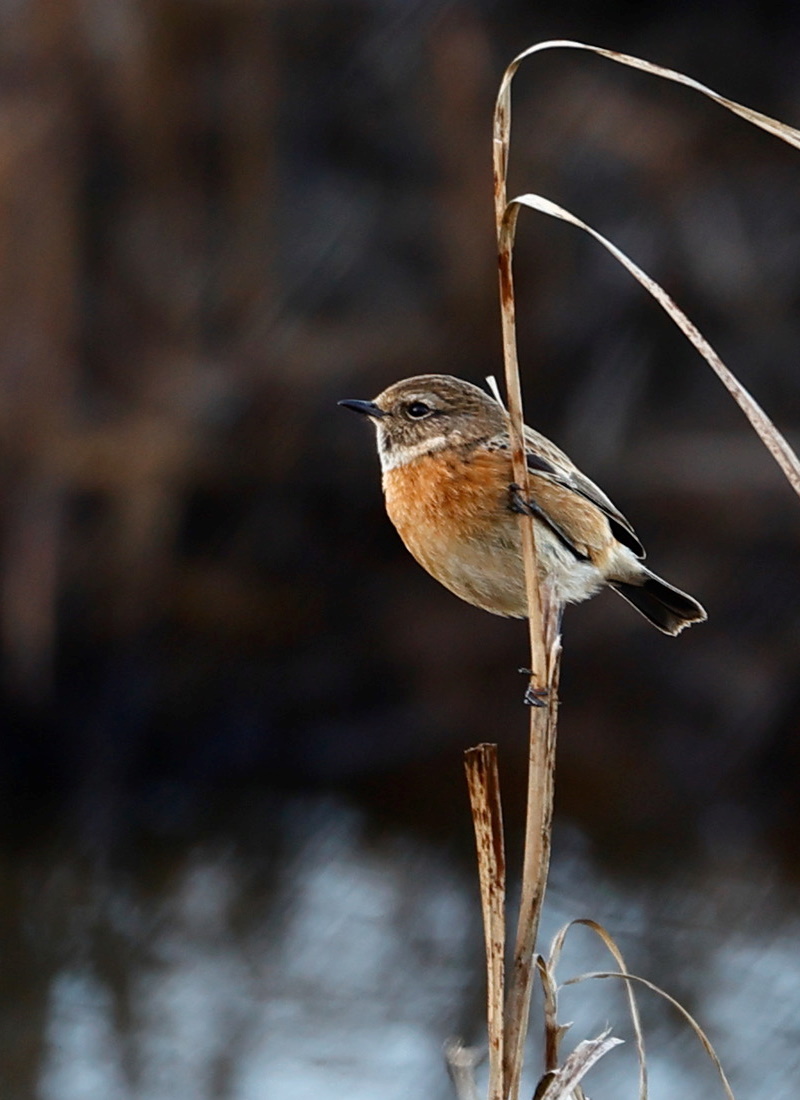
What to expect in March
March
sees the return of spring and the return of the spring migrants. Below
is the table for 2020 (and the previous two years) showing the first
sightings for a selection of species.
If you see an early migrant please email
 and,
if it's a first,
I'll put it in the 2021 table.
and,
if it's a first,
I'll put it in the 2021 table.
| Species | 2020 | Location | 2019 | 2018 |
|---|---|---|---|---|
| White Wagtail | 1st March | Leasowe | 28th
Feb |
14th March |
| Sand Martin | 16th
March |
Leasowe | 16th Feb | 15th March |
| Wheatear | 16th March | Leasowe | 27th
Feb |
9th March |
| Swallow | 23rd March | Leasowe | 21st March | 29th March |
| Willow Warbler | 26th March | Hoylake
and Heswall |
24th March | 27th March |
| House Martin | 5th
April |
Leasowe | 31st March | 6th April |
| Whitethroat | 8th
April |
Heswall | 14th April | 7th April |
| Swift | 21st
April |
West
Kirby
and Leasowe |
23rd April | 22nd April |
| Cuckoo | 23rd
April |
Arrowe Park | 18th April | 23rd April |
As I write this at the end of February we've already seen our first
Wheatear and Sand Martins won't be far behind having already been
spotted on the Mersey Estuary. Other migrants will include Avocets and
should reach over 100 at Burton Mere Wetlands. Out to sea look out for
Little Gulls, they fly north-eastwards past our coast before flying
overland to the North Sea on their way to the Baltic to breed. Common
Scoters may well be in their thousands out in Liverpool Bay as they
also are on the way to the Baltic. We should also see our first Osprey
or two of the spring fly north.
There are some big high tides due in March and if they cover the marshes there should be plenty to see including thousands of Pink-footed Geese and the usual Marsh and Hen Harriers. Normally Short-eared Owls would be a certainty but they have been absent this winter, but it may well be that we see one or two on passage.
There will be signs of breeding and look out at Burton Mere Wetlands for Mediterranean Gulls, Bearded Tits, Marsh Harriers, Great Egrets, perhaps Cattle Egrets and even Spoonbills. Look out for display flights of Marsh Harriers which can be spectacular.
Forthcoming Events
March Highest Spring Tides (Liverpool)
Also see Tides page.
1st March, 12.31hrs (GMT), 9.8m.
2nd March, 13.11hrs (GMT), 9.8m.
29th March, 12.27hrs (BST), 9.9m.
30th March, 13.07hrs (BST), 10.0m.
31st March, 13.48hrs (BST), 10.0m.